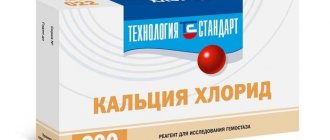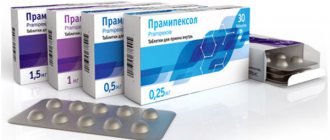Suxamethonium iodide is a drug (solution) (pharmacological group - muscle relaxants). The medicine is characterized by the following application features:
How to dissolve vascular plaques, normalize blood circulation, blood pressure and forget the way to the pharmacy
- Sold only with a doctor's prescription
- During pregnancy: contraindicated
- When breastfeeding: with caution
- In childhood: contraindicated
- For liver dysfunction: contraindicated
- If renal function is impaired: with caution
Pharmacodynamics and pharmacokinetics
Ditilin acts as a short-acting depolarizing muscle relaxant . Taking suxamethonium iodide leads to blocking of neuromuscular communication. Through stimulation of n-cholinergic receptors of the end plate occurs . The spread of the process affects the adjacent membranes , and a disorganized generalized contraction of myofibrils (that is, the formation of a blockade is preceded by muscle twitching , as a result of short-term suppression of neuromuscular communication).
Remaining depolarized, the membranes do not respond to additional impulses , since to maintain muscle tone it is necessary to supply repeated impulses , which are associated with repolarization of the end plate , spastic paralysis .
After an IV injection of Ditilin, muscle relaxation occurs in the following progression: eyelids , jaws , fingers, organs of vision , limbs, neck , abdomen and back , vocal cords, after which the relaxation concerns the intercostal muscles and diaphragm .
Also, the administration of suxamethonium iodide , under general anesthesia , increases cerebral blood flow and intracranial pressure .
When administered intramuscularly, the onset of action is observed in the 2-4th minute, when administered intravenously after 54-60 seconds. Maximum relaxation is established after 2-3 minutes and is fully maintained for 3 minutes, then decreases within 5-10 minutes.
The severity of the effect is determined by the size of the administered dose:
- with the introduction of 0.1 mg/kg, relaxation of the skeletal muscles without a significant effect on the muscles of the respiratory system ;
- with the introduction of 0.2-1 mg/kg, complete relaxation of the muscles of the peritoneum and respiratory system (a significant decrease or complete cessation of spontaneous breathing ).
For muscle relaxation over a longer period of time, repeated injections are necessary. The rapid achievement of the effect and the rapid further restoration of muscle tone allow the formation of controlled and controlled muscle relaxation .
After intravenous administration, it is distributed both in plasma and in extracellular fluid.
With the help of cholinesterase, more than 90% is hydrolyzed to choline and succinic acid. T1/2, with a normal level of cholinesterase , is equal to 90 seconds.
It is excreted in the urine, does not accumulate and does not penetrate the BBB.
pharmachologic effect
Pharmacology:
Pharmacological action: muscle relaxant. Short-acting depolarizing muscle relaxant. It disrupts the conduction of neuromuscular excitation and causes relaxation of skeletal muscles. Competes with acetylcholine for n-cholinergic receptors, causes persistent depolarization of the end plate due to high affinity for cholinergic receptors and resistance to acetylcholinesterase. Initially, the development of depolarization is manifested by fasciculations (generalized disorganized contraction of myofibrils) due to short-term facilitation of neuromuscular transmission, then the depolarized membranes stop responding to additional impulses and a myoparalytic effect occurs (spastic paralysis occurs). After IV administration, muscle relaxation develops in the following sequence: muscles of the fingers, eyes, legs, neck, back; then the intercostal muscles and the diaphragm. Causes an increase in cerebral blood flow and intracranial pressure under conditions of weak general anesthesia. After intramuscular administration, the effect develops after 2-4 minutes, after intravenous administration - after 54-60 s, the maximum effect develops after 2-3 minutes and remains in full for 3 minutes. Duration of action is 5-10 minutes. The severity of the effect depends on the dose: 0.1 mg/kg - relaxation of skeletal muscles without a significant effect on the respiratory system, 0.2-1 mg/kg - complete relaxation of the muscles of the abdominal wall and respiratory muscles (significant limitation or complete cessation of spontaneous breathing). Has a quick and short-term effect. Does not accumulate. For long-term muscle relaxation, repeated administration is necessary. The rapid onset of the effect and the subsequent rapid restoration of neuromuscular conduction make it possible to create controlled and manageable muscle relaxation. After IV administration, it is distributed in plasma and extracellular fluid. More than 90% is hydrolyzed by blood pseudocholinesterase to succinic acid and choline. T_1/2 - 90 s with normal pseudocholinesterase levels. Excreted by the kidneys. Does not penetrate the intact BBB.
Indications for use
Ditilin solution is indicated for:
- tetanus , as a drug for symptomatic treatment;
- performing bronchoscopy and intratracheal intubation to stop spontaneous breathing ;
- carrying out endoscopy , repositioning of fractures , reduction of dislocations , gynecological, abdominal and thoracic operations, for complete muscle relaxation ;
- strychnine poisoning ;
- conducting electrical pulse therapy to prevent seizures .
Contraindications
- malignant hyperthermia (both currently observed and in history);
- hypersensitivity;
- myasthenia gravis;
- Duchenne muscular dystrophy;
- dystrophic and congenital myotonia ;
- angle-closure glaucoma;
- pulmonary edema;
- acute liver failure;
- pregnancy;
- penetrating injuries to the organs of vision;
- hyperkalemia;
- lactation period;
- bronchial asthma;
- age up to 12 months.
Carefully:
- serum cholinesterase activity end-stage liver failure anemia , prolonged fasting , cachexia , chronic infections, trauma, widespread burns);
- postpartum period;
- tuberculosis;
- tetanus;
- malignant neoplasms;
- myxedema;
- chronic kidney failure;
- systemic pathologies of connective tissue;
- artificial circulation;
- plasmapheresis;
- period after plasma transfusion ;
- intoxication with insecticides - cholinesterase inhibitors (when taken orally) or anticholinesterase drugs ( neostigmine , distigmine bromide, physostigmine );
- unscheduled surgical operations in patients with a “full stomach”;
- parallel use of drugs that compete with suxamethonium for cholinesterase (for example, intravenous administration of Procaine ).
Suxamethonium chloride
Release form, composition and packaging
The solution for intravenous and intramuscular administration is transparent, colorless or with a slightly yellowish tint.
| 1 ml | 1 amp. | |
| suxamethonium chloride | 20 mg | 100 mg |
Excipients: sodium chloride, disodium salt of ethylenediaminetetraacetic acid (Trilon B), water for injection.
5 ml - ampoules (5) contour cell packaging (1) - cardboard packs.
5 ml - ampoules (5) contour cell packaging (2) - cardboard packs.
5 ml - ampoules (10) - cardboard packs.
Clinical and pharmacological group: Muscle relaxant of peripheral action of depolarizing type
Registration No.:
- solution for intravenous and intramuscular administration of 100 mg/5 ml: amp. 5 or 10 pcs. — R No. 003409/01, 02.06.04
pharmachologic effect
Depolarizing muscle relaxant of peripheral action. Causes a blockade of neuromuscular transmission. Interacting with n-cholinergic receptors, it causes depolarization of the end plate. The process spreads to the adjacent membranes, and a generalized disorganized contraction of myofibrils occurs (i.e., the development of blockade is preceded by muscle twitching - the result of short-term facilitation of neuromuscular transmission). The membranes, remaining depolarized, do not respond to additional impulses, since maintaining muscle tone requires the receipt of repeated impulses associated with repolarization of the end plate, spastic paralysis occurs. After IV administration, muscle relaxation occurs in the following sequence: muscles of the fingers, eyes, legs, neck, back; then the intercostal muscles and the diaphragm. Increases cerebral blood flow and intracranial pressure under general anesthesia.
After intramuscular administration, the effect develops within 2-4 minutes; after IV administration - after 54-60 seconds, after 2-3 minutes muscle relaxation reaches a maximum and remains in full for 3 minutes. Duration of action - 5-10 minutes. The severity of the effect depends on the size of the administered dose: 100 mcg/kg - relaxation of skeletal muscles without a significant effect on the respiratory system; 0.2-1 mg/kg - complete relaxation of the muscles of the abdominal wall and respiratory muscles (there is a significant limitation or complete stop of spontaneous breathing). For long-term muscle relaxation, repeated administration is necessary. The rapid onset of the effect and the subsequent rapid restoration of muscle tone make it possible to create controlled muscle relaxation.
Pharmacokinetics
Distribution
After IV administration, it is distributed in plasma and extracellular fluid. Does not penetrate the intact BBB. Does not accumulate.
Metabolism
More than 90% is hydrolyzed by blood cholinesterase to succinic acid and choline.
Removal
T1/2 is 90 seconds with normal cholinesterase levels. Excreted by the kidneys - 10% unchanged.
Indications
Interventions requiring short-term muscle relaxation:
- disabling spontaneous breathing (intratracheal intubation, bronchoscopy);
- complete muscle relaxation (endoscopy, reduction of dislocations, reduction of fractures, gynecological, thoracic and abdominal surgeries);
- prevention of seizures during electrical pulse therapy;
- strychnine poisoning;
- tetanus (symptomatic therapy).
Dosage regimen
The drug is administered intravenously (stream, drip), intramuscularly.
Adults are administered intravenously slowly, in a stream or drip. Depending on the clinical situation, when administered intravenously, a single dose varies from 100 mcg/kg to 1.5-2 mg/kg.
IM is administered at a dose of 3-4 mg/kg, but not more than 150 mg.
For children, the drug is administered intramuscularly in doses of up to 2.5 mg/kg, but not more than 150 mg, intravenously in doses of 1-2 mg/kg.
For tracheal intubation, the dose is 200-800 mcg/kg; for muscle relaxation and shutdown of spontaneous breathing, the dose is 0.2-1 mg/kg; for relaxation of skeletal muscles during the reduction of dislocations and reposition of bone fragments in fractures - 100-200 mcg/kg, for endoscopy the dose is 200 mcg/kg; to prevent complications during electroconvulsive therapy (convulsions, separation of muscles and tendons) - 0.1-1 mg/kg IV, but not more than 150 mg. For long-term muscle relaxation, 0.5-1 mg/kg can be administered fractionally, every 5-7 minutes, throughout the entire operation. Repeated doses last longer.
Side effect
Allergic reactions: anaphylactic shock, bronchospasm.
From the side of water and electrolyte balance: hyperkalemia.
From the cardiovascular system: arrhythmias, decreased blood pressure, bradycardia (more often in children, with repeated administration in children and adults), conduction disturbances, cardiogenic shock.
From the organ of vision: increased intraocular pressure.
From the musculoskeletal system: myalgia (in the postoperative period), rhabdomyolysis with the development of myoglobinemia and myoglobinuria.
From the respiratory system: prolonged paralysis of the respiratory muscles (associated with a genetically determined disorder in the production of pseudocholinesterase).
Other: hypersalivation, fever.
Contraindications
- malignant hyperthermia (including history);
- myasthenia gravis;
- congenital and dystrophic myotonia;
- Duchenne muscular dystrophy;
- angle-closure glaucoma;
- acute liver failure;
- pulmonary edema;
- penetrating eye injuries;
- cholinesterase deficiency;
- bronchial asthma;
- hyperkalemia;
- pregnancy;
- children under 1 year of age;
- hypersensitivity to the components of the drug.
With caution: emergency surgery in patients with a “full stomach”, decreased serum cholinesterase activity (end-stage liver failure), anemia, cachexia, prolonged fasting, chronic infections, widespread burns, trauma, the postpartum period, tetanus, heart failure, tuberculosis, malignant neoplasms, chronic renal failure, myxedema, collagen diseases, after plasma transfusion, plasmapheresis, artificial circulation, acute or chronic intoxication with insecticides - cholinesterase inhibitors (if ingested) or anticholinesterase drugs (neostigmine, physostigmine, distigmine, phospholine), simultaneous use of drugs, competing with suxamethonium for cholinesterase (including intravenous procaine).
Use during pregnancy and breastfeeding
The drug is contraindicated for use during pregnancy.
Data on the safety of the drug during lactation are not provided.
Use for liver dysfunction
With caution: decreased serum cholinesterase activity (end-stage liver failure.
Use for renal impairment
In patients with chronic renal failure (without signs of hyperkalemia and neuropathy), suxamethonium is administered once in medium doses, but is not used for repeated administration or in higher doses due to the risk of developing hyperkalemia.
special instructions
The drug should be used only in a specialized department, in the presence of equipment for artificial ventilation of the lungs and personnel who know this equipment, and against the background of general anesthesia.
Administration of d-tubocurarine (3-4 mg) or diplacin (10-13 mg) 1 minute before suxamethonium almost completely prevents muscle twitching and subsequent myalgia.
With an appropriate dose and repeated administration, suxamethonium can be used for longer operations; however, for long-term muscle relaxation, non-depolarizing muscle relaxants are usually used, which are administered after preliminary tracheal intubation against the background of suxamethonium.
To prevent severe bradycardia, increased bronchial secretion and other effects associated with m-cholinergic stimulating effects, it is recommended to administer atropine before administering suxamethonium.
In patients with chronic renal failure (without signs of hyperkalemia and neuropathy), suxamethonium is administered once in medium doses, but is not used for repeated administration or in higher doses due to the risk of developing hyperkalemia.
Prolonged muscle relaxation with possible apnea can be caused by several reasons: serum pseudocholinesterase, hereditary deficiency of serum cholinesterase or a temporary decrease in its level in severe liver diseases, severe anemia, after prolonged fasting, cachexia, dehydration.
Side effects
- hyperkalemia;
- decreased blood pressure;
- arrhythmia;
- cardiac conduction disturbance ;
- bradycardia;
- increased intraocular pressure ;
- cardiogenic shock;
- hypersalivation;
- myalgia (in the postoperative period);
- fever;
- prolonged paralysis of the muscles of the respiratory system (caused by genetic disorders of cholinesterase );
- bronchospasm;
- rhabdomyolysis with the formation of myoglobinuria and myoglobinemia ;
- anaphylactic shock.
Within 10-12 hours after injection of Ditilin, muscle pain .
In patients of childhood and adolescence, as well as women (especially vagotonic ), short-term bradycardia , sometimes asystole, .
muscle relaxation , as well as prolonged apnea, were sometimes observed .
Instructions for use of Ditilin (Method and dosage)
The official instructions for use of Ditilin recommend using the injection solution both intramuscularly and intravenously (drip or stream).
As a rule, adults are prescribed IV drip or slow stream (a 0.1% solution is prepared for infusion). In accordance with the clinical picture, single intravenous administration is carried out in doses from 100 mcg to 1.5-2 mg per kilogram of weight.
IM administration is prescribed to children in a dosage of up to 2.5 mg/kg (not more than 150 mg), IV dosage is usually 1-2 mg/kg.
For tracheal intubation, 0.2-0.8 mg of the drug per kilogram of weight is used.
To stop spontaneous breathing and muscle relaxation , it is recommended to use 0.2-1 mg/kg of solution.
To relax the skeletal muscles , to reposition bone fragments , to reduce dislocations and fractures , 0.1-0.2 mg/kg of the drug is used.
For endoscopy , 0.2 mg/kg is prescribed.
In electropulse therapy , in order to prevent complications ( separation of tendons and muscles , convulsions ), 0.1-1 mg/kg is used for intravenous administration and up to 2.5 mg/kg for intramuscular administration (no more than 150 mg).
For long-term muscle relaxation , throughout the entire surgical intervention, it is possible to administer the solution fractionally, 0.5-1 mg/kg every 5-7 minutes. It should be taken into account that repeated administrations act over a longer period of time.
Release form
solution for intravenous administration 20 mg/ml; ampoule 5 ml with ampoule knife, contour plastic packaging (pallets) 5, cardboard pack 1. solution for intravenous administration 20 mg/ml; ampoule 5 ml with ampoule knife, contour plastic packaging (pallets) 5, cardboard pack 2. solution for intravenous administration 20 mg/ml; ampoule 5 ml with ampoule knife, contour plastic packaging (pallets) 10, cardboard pack 1. solution for intravenous administration 20 mg/ml; ampoule 5 ml with ampoule knife, contour plastic packaging (pallets) 10, cardboard pack 2. solution for intravenous administration 20 mg/ml; ampoule 5 ml with ampoule knife, cardboard pack 10. solution for intravenous administration 20 mg/ml; ampoule 5 ml with ampoule knife, contour plastic packaging (pallets) 5, cardboard pack 1. solution for intravenous administration 20 mg/ml; ampoule 5 ml with ampoule knife, contour plastic packaging (pallets) 5, cardboard pack 2. solution for intravenous administration 20 mg/ml; ampoule 5 ml with ampoule knife, contour plastic packaging (pallets) 10, cardboard pack 1. solution for intravenous administration 20 mg/ml; ampoule 5 ml with ampoule knife, contour plastic packaging (pallets) 10, cardboard pack 2. solution for intravenous administration 20 mg/ml; ampoule 5 ml with ampoule knife, cardboard pack 10. solution for intravenous administration 20 mg/ml; ampoule 10 ml with ampoule knife, cardboard pack 10. solution for intravenous administration 20 mg/ml; ampoule 10 ml with ampoule knife, contour plastic packaging (pallets) 5, cardboard pack 1. solution for intravenous administration 20 mg/ml; ampoule 10 ml with ampoule knife, contour plastic packaging (pallets) 5, cardboard pack 2. solution for intravenous administration 20 mg/ml; ampoule 10 ml with ampoule knife, contour plastic packaging (pallets) 10, cardboard pack 1. solution for intravenous administration 20 mg/ml; 10 ml ampoule with ampoule knife, contour plastic packaging (pallets) 10, cardboard pack 2.
Interaction
Ditilin solution is pharmaceutically incompatible with blood products and donor blood (due to hydrolysis), as well as with alkaline solutions and barbiturate solutions (due to the formation of sediment).
Ringer's solution , 6% dextran , isotonic solutions of sodium chloride, 5% fructose , narcotic analgesics , and other muscle relaxants .
Aminoglycoside antibiotics , anticholinesterase agents, Procainamide , Procaine , Lidocaine , beta-blockers, Verapamil , Amphotericin B , Cyclopropane , Clindamycin , Propanidide , Li+ and Mg2+ salts, Pancuronium , organophosphorus insecticides , Quinine , Quinidine , chloroquine prolong and enhance muscle relaxant effectiveness of Ditilin.
Suxamethonium reduces the effectiveness of antimyasthenic .
Ditilin enhances the cardiac effect of cardiac glycosides (the development of bradycardia ).
Halogen-containing drugs used during general anesthesia increase, and A tropine and T iopental reduce the negative effects on the cardiovascular system.
Medicines that can reduce the activity of plasma cholinesterase ( oral contraceptives , Diphenhydramine , Aprotinin , Promegazin , Oxytocin , estrogens , high doses of glucocorticoids ) prolong and enhance the muscle relaxant effects of Ditilin.
Drug interactions
When used simultaneously with Suxamethonium chloride:
- cardiac glycosides: their therapeutic effect is enhanced;
- medications for the treatment of myasthenia gravis: their effectiveness decreases;
- anticholinesterase agents, lidocaine, procaine, procainamide, verapamil, magnesium and lithium salts, beta-blockers, aminoglycoside antibiotics, propanidide, clindamycin, cyclopropane, amphotericin B, quinine, chloroquine, quinidine, organophosphorus insecticides, pancuronium bromide: combination with each of the listed drugs enhances and prolongs the muscle relaxant effect of the drug;
- other muscle relaxants, narcotic analgesics: no interaction with these drugs is observed;
- halogen-containing agents for general anesthesia: their undesirable effect on the cardiovascular system increases;
- sodium thiopental, atropine: these drugs help reduce the negative effect on the cardiovascular system;
- aprotinin, diphenhydramine, oxytocin, promethazine, glucocorticosteroids (in high doses), estrogens, oral contraceptives: against the background of concomitant therapy with each of these or other drugs with the potential to reduce cholinesterase activity in the blood, the effect of Suxamethonium chloride is enhanced and prolonged.
The solution is pharmaceutically incompatible with blood products, blood preservatives, donor blood, serum preservatives, barbiturate solutions and alkaline solutions.
special instructions
Ditilin is indicated for use only in specialized medical institutions, under general anesthesia and in the presence of equipment for ventilation .
The introduction of 10-15 mg of diplacin chloride or 3-4 mg of tubocurarine , 60 seconds before the infusion of Ditilin, prevents fibrillary muscle twitching and the further development of muscle pain .
Slow administration of Ditilin solution, as well as a previous intravenous injection of 1.5 mg of atropine , significantly prevents bradycardia , as well as an increase in bronchial secretion .
With repeated administration of appropriate doses of Ditilin, it can be prescribed for longer operations; however, for long-term muscle relaxation non-depolarizing muscle relaxants are most often used , administered after tracheal intubation using suxamethonium iodide .
Administration of the drug to patients with renal failure (without signs of neuropathy and hyperkalemia ) should take place in medium doses, without subsequent repetitions of injections or the use of high dosages, due to the risk of developing hyperkalemia .
Prolonged muscle relaxation with the development of apnea can occur due to cholinesterase deficiency : “atypical”, hereditary, or due to a temporary decrease in its level.
With repeated administration of Ditilin, if muscle tone 25-30 minutes after the last injection, and shallow breathing continues, we can conclude that the depolarizing block has transitioned to an antidepolarizing block (formation of a “double block”).
In this case, it is recommended to use Proserin according to the generally accepted method: preliminary administration of 0.5-0.7 mg of a 1% solution of Tropine A , until the pulse increases (usually 60-120 seconds), after which iv administration of 1.5 mg ( 3 ml) 0.05% Proserin .
Analogues of the drug according to ATC codes:
DITILIN DITILIN DITILIN-DARNITSA SUXAMETHONIUM CHLORIDE
You should consult your doctor before using SUXAMETHONIUM IODIDE. These instructions for use are for informational purposes only. For more complete information, please refer to the manufacturer's instructions.








